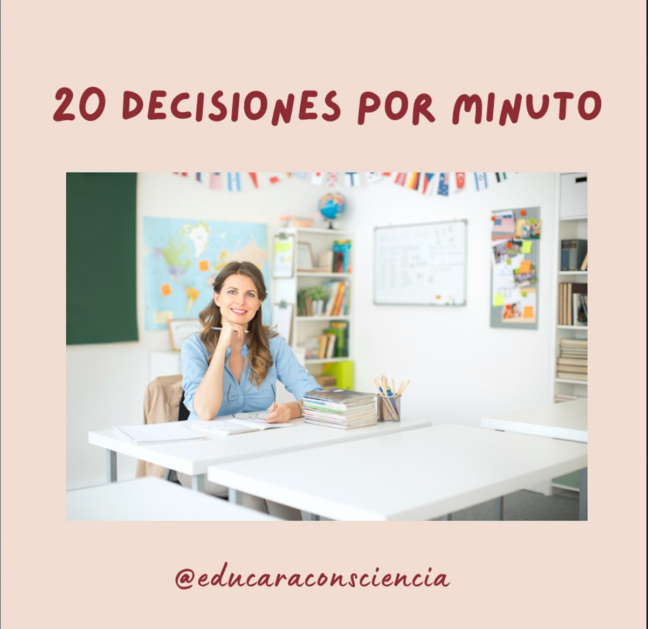by Justa Rebollo Paz (LTL Contributor)

20 Decisiones por minuto
🤎 Débora Ball, de la Universidad de Michigan, afirma que los docentes toman un promedio de 20 decisiones en el lapso de un minuto y medio; y nos alerta sobre la necesidad de que éstas no queden libradas al azar, ya que de eso depende la calidad de lo que se enseñe.
🤎 De las decisiones que toma un docente en una clase, se calcula que el 97% se tomarán de forma rápida e inconsciente. 🤎Este tipo de decisiones, si bien son efectivas para resolver situaciones rápidas, son las más proclives a errores.
🤎 Muchas de ellas son decisiones pequeñas, de gestión en el aula, de motivar a ciertos alumnos de manera distinta que a otros, de intervenir frente a una situación disruptiva, de cambiar de estrategia cuando alguna no es suficiente, de tareas administrativas o de logística, de cómo transmitir conocimientos dejando que sus alumnos experimenten, planificación de actividades, cambio de voz, observaciones, etc.
🤎 Por otra parte la Dra. Bondie, profesora de la Escuela de Educación de la Universidad de Harvard, propone que los docentes analicen sus decisiones diarias, tomándose un tiempo para pensar en profundidad sobre las elecciones realizadas y los motivos que las llevaron a tomarlas.
🤎 Para esto es importante tener al día la planificación diaria o semanal.
🤎 Como directivos tenemos la responsabilidad de demandar y exigir la planificación, no solamente para supervisar y estar al tanto de lo que se hace, sino para colaborar con la efectividad y calidad de la enseñanza, y evitarles tanto estrés a los docentes.
🤎 La propuesta es que podamos reflexionar en cada comunidad educativa en la búsqueda individual y colectiva de mejora de nuestras decisiones en el aula, y en la escuela.
20 Decisions per Minute
🤎 Deborah Ball, from the University of Michigan, states that teachers make an average of 20 decisions in the span of a minute and a half; and alerts us to the need for them not to be left to chance, since the quality of what is taught/learned depends on that.
🤎 Of the decisions a teacher makes in a class, it is estimated that 97% will be made quickly and unconsciously. 🤎 These types of decisions, while effective in resolving quick situations, are the most prone to errors.
🤎 Many of them are small decisions: classroom management, motivating certain students differently than others, intervening in a disruptive situation, changing strategies when one is not enough, making tasks that are administrative in nature or about logistics, on how to transmit knowledge by letting your students experiment, activity planning, changing voices to grab students’ attention, observations, etc.
🤎 On the other hand, Dr. Bondie, a professor at the Harvard University School of Education at Harvard University, proposes that teachers analyze their daily decisions, taking time to think in depth about the choices made and the reasons that led them to making them.
🤎 For this, it is important to keep up with the daily or weekly planning.
🤎 As leaders we have the responsibility to demand and demand planning, not only to monitor and be aware of what is being done, but also to collaborate with the effectiveness and quality of teaching, thus, avoiding more stress to teachers.
🤎 The proposal is that we reflect in each educational community on the individual and collective quest to improve our decisions in the classroom, and at school.
